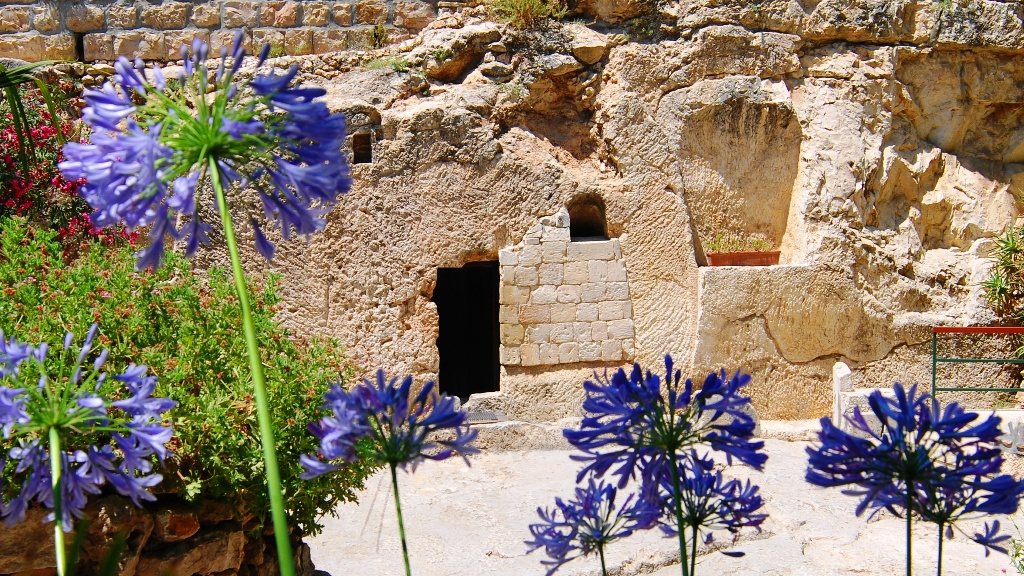The Signs of the Times (44): Resurrection
‘Finally the other disciple, who had reached the tomb first, also went inside. He saw and believed.’
John 20:8 (NIV)
Christ is Risen. That is not a fairy tale. Not something that one has to ‘believe’ by putting one’s mind out of action and one’s brains to a standstill and then jump into blind faith. No, the Bible is a book of realities. People like you and me reported in the Bible about astonishing facts. And they were as flabbergasted as we would have been, if we had been in the same place at the same time as they were.
The friends of Jesus were down-to-earth people. Fishermen – and Jewish. One does not take people like that for a ride. Or impose fancy stories upon them. But they were witnesses of astonishing facts, and they had a hard time to come to believe them. But facts one cannot deny, can one?
The Apostle John later writes: ‘That which we have heard, which we have seen with our eyes, which we have looked at and our hands have touched – this we proclaim (…) We proclaim to you what we have seen and heard (…) We write this to make our joy complete’ (1 John 1:1-4). Seen with their eyes and heard with their ears. And then total joy finally prevailed, after all the astonishment and shaky feelings, doubts and hopes, and finally total conviction!
Because one cannot deny the facts, can one? John was there. He saw and believed. In his gospel he writes in John 20:6-8: ‘Then Simon Peter who was behind him (John) arrived and went into the tomb, and he saw the strips of linen lying there, as well as the burial cloth that had been around Jesus head (…) Finally the other disciple (John), who had reached the tomb first, also went inside. He saw and believed.’
Now it has always puzzled me: what did John see that made him believe? What was there to see? Only the grave cloth. He saw the strips of linen in which the body of Jesus had been buried.
Joseph of Arimathea and Nicodemus were given permission by Pontius Pilate to bury the body of Jesus. To do so they had brought with them a mixture of myrrh and aloes, about 75 pounds, John 20:38-42! They buried the body of Jesus in the way the Jews were accustomed to do it. Jews did not mummify the dead bodies as the Egyptians did. They left the corpse intact, but wrapped it into long pieces of linen: one for the head and one for the body. They simply wrapped the whole body in the cloth while adding these oils, spices, anointments, herbs, aloes, etc. to prevent the bad smell, the stench of a decaying body. To make sure that instead of that the sweet odor of these spices would prevail.
Then they laid the body wrapped up like this unto a couch of stone, hewn in the back wall of the cave in the rocks. The body on the stone bench and the head on the stone ‘pillow’. Then a huge stone was rolled before the entrance of the cave to prevent grave-robbery, or animals to come in to scavenge the body.
After some time these oils, herbs, spices, aloes and myrrh dried up, giving the grave cloth and strips of linen in which the body was buried a certain stiffness. It would have been very difficult, even impossible to unwrap them and take the body out.
So what did John see that made him believe? Had he seen the strips of linen and the burial cloth thrown as a bundle somewhere in a corner of the cave, he would have thought: ‘what on earth has happened here?’ He would not have come to the conclusion: O, bodily resurrection must have taken place! Even if he had found them neatly folded in a pile on the stone bench, he still would have thought: ‘what did happen here, where is the body, who did this, etc.?’ He must have seen the linen in its original form of the body – but without the body! The linen untouched!
When John saw the grave cloth in the form of the body – but without a body – the only logical conclusion he could have come to is this: somehow the body must have risen through the ‘burial-cloth’! Because it is impossible to unwrap the body, then remove the body, and then put the stripes of linen and the burial cloth back into the form of the body. The 75 pounds of mixture of myrrh and aloes simply would make that impossible. So He must have risen through the linen. How? One does not know. One cannot explain it, but it is the only logical explanation, John must have thought. He must have risen through the ‘burial-cloth’!
And if wrapped burial-cloth could not keep Him, neither could the stone rolled before the entrance. Neither could a room with the doors closed keep Him outside. He simply stood in their midst, with the doors closed. He appears and disappears as it pleases Him. In this incredible resurrection body, with unheard of wonderful properties. Crossing over between the earthly dimensions and the other, heavenly dimensions that surround us.
So the stone was removed not to let Him out, but to let us in! In order that we could see with our own eyes and give testimony about these facts, incredible as they seem to be. John saw and believed. And he is telling us what he saw in order that we might believe. Jesus rose from the dead. The grave was empty. And only because the grave was empty, we start to understand the meaning of the cross. It was not just a martyr’s death. But sacrifice for sin.
Because if God one-day would accept a sacrifice for sin, atonement for sin, redemption of sin, then the result must be that the consequence of sin – being ‘death’ – would simply disappear. And it happened. He crossed out ‘sin’ and therefore crossed out ‘death’ as well. Praise the Lord! The grave was empty. Death could not control Jesus anymore. So His death on the cross must have been the atonement for sin. The empty tomb is the proof of the validity of the cross. Free at last! And this is only the beginning. Those who put their faith in Jesus will rise in glory as well, with the same resurrected body that He had – and has, for that matter.
One-day the whole of creation will be made free as well. Paul writes about it in Romans 8:18-23. Jesus rose from the dead. And when He returns in glory, the Apostle John says: ‘Dear friends, now we are children of God, and what we will be has not yet been made known. But we know that when Christ appears, we shall be like Him, for we shall see Him as He is.’ (1 John 3:2)
‘For our citizenship is in heaven, from which we also eagerly wait for the Saviour, who, by the power that enables Him to bring everything under His control, will transform our lowly bodies so that they will be like His glorious body.’ (Philippians 3:20-21)
The Lord has risen! He says: ‘…I live, you also will live…’ John 14:19.
Many people are afraid of the future. Will the turmoil in the world lead to World War III? Or is there still hope? What do the ancient prophecies of the Bible teach us? Are we at the beginning of the end of this world? Or are we approaching a new beginning? Could Israel be a sign of hope? In this new series Rev. Willem Glashouwer looks at 52 of the many signs of the times that are mentioned in the Bible. The English edition of ‘The Signs of the Times’ is available in our webshop. Order today!






